#urban experience

I always advocated approaching the urban design issue in city with improving public spaces and pedestrian areas. There’s a lot that can be achieved just by focusing on few important elements such as the people who flood our streets.
In the past years we sadly witnessed the death of innocent people by the hand of radical Islamic terrorists who used vehicles to fulfill their nefarious plans. Public security is at its highest alert since the events of September 11 2001 in the United States, and perhaps we can now help cities both ways in terms of security and decor.
Governments can continue to spend millions on local security among hot-spots some cities might be vulnerable; police and army personnel are siding to keep communities safe across Europe during this wave of radical terror. However, we can make cities safe when we decide to use simpler approaches to limit traffic and potential threats in specific areas.

Common cement road barriers downtown Milan resemble Checkpoint Charlie in post-WW2 Berlin.
We don’t need to turn roads and intersections into Cold War security checkpoints, we just need to use urban landscaping tools and reshape them into spots that can blend within blocks and avoid any uncomfortable and insecure atmosphere among people. It’s important to create smart urban solutions that don’t trigger the population into believing there’s any threat.
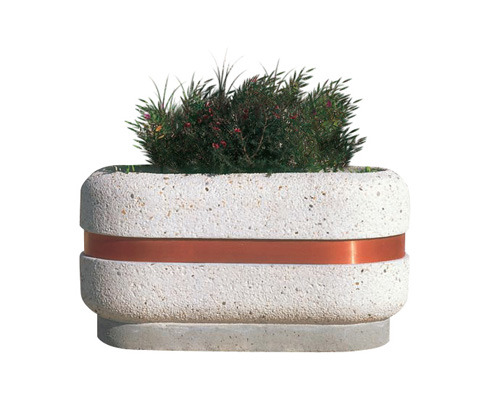
A heavy cement flower pot is the best way to combine decor and security feature in one object.
Cities can safely implements large gardening objects like flowerpots made of cements to be placed where sensible gateways needs to be protected. The decor element of nature will play the advantage point while enhancing the security methods where needed.
These important and hefty pots are already everywhere used as decorative elements in many cities across Europe, some even have horizontal planks functioning as bench-element for pedestrian to use. This system is both eye-friendly and it doesn’t stand out as something alienating for the user to experience.
Any of these objects comes with a considerable weight that can improve the security of those city spots in need of safety; they act as dead weight to stop any moving vehicle by acting as physical barriers defending people. The plus side is they can be arranged to fit the decor and theme any city sports by changing pot size, weight, flora, pattern.
A selection of these pots placed according to the city’s strategic need has the full potential to stop any commonly driven vehicles to create disaster. People will be protected without knowing enforced barriers have been placed.

Detroit has been through decades of social and financial problems ever since the city slowly slumped into oblivion and collapsing on itself until bankruptcy. The auto industry fueled the city’s growth for many years starting at the beginning of the 20th century with the advent of the automobile.
Fast-forward to the 21st century and everything is gone from the city once thrived with the biggest industry of the West. But it wasn’t enough for Detroit as it gamble its entire economy on cars rather than diversifying the industry investing in different fields. By the time politicians realized that it was too late.
We can trace back how the city developed into something fit only for those having the ability to afford cars, while the rest of those who relied on walking were left out of the equation for good. Today Detroit still lags behind in having an effecting public transportation system to make a significant impact, but it’s very hard when the entire city was developed inside the car-culture.
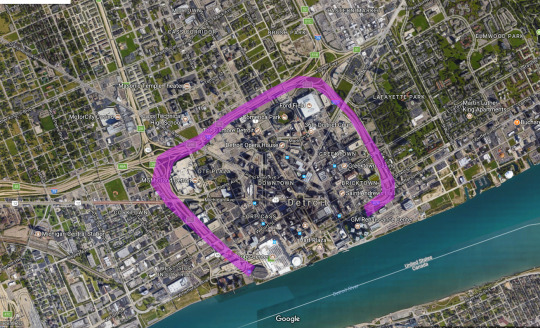
Three freeways isolate downtown from the rest transforming it in a citadel.
One of the main issues that affected the urban development and prevented the city from adopting a better road system, was the the layout of the freeway system that chokes downtown Detroit. The John C. Lodge, Fisher, and Chrysler freeways surround the urban center isolating it from the rest of the city.
Artificial barriers in the form of roads, ramps, collectors, are responsible for creating specific condition among neighbors, mostly negatively impacting hundreds of blocks at the time. Developers find this method very useful to separate high and low values housing so it won’t affect the pricing market, thus ensuring specific parts of town remain within a specific yield of profits.
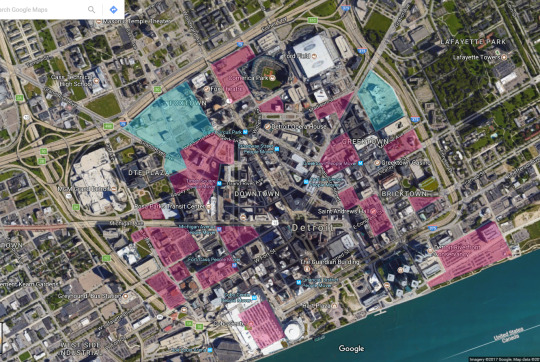
Another important issue is the large presence of parking lots surface downtown. Highlighted in red the volumes dedicated to car parking are spread out comprising a large portion of the city core. Whenever cars have a place to be stored they will create incentive to use them everywhere as an extension of people’s lives that cannot be excluded.
The two portions in blue represent large areas of vacant lots that once hosted buildings. Today they leave tremendous gaps between blocks that reminds of Berlin in 1946 after the rubble removal. Focusing on the site located on the top-left corner we can comprehend how much Detroit has been neglected.
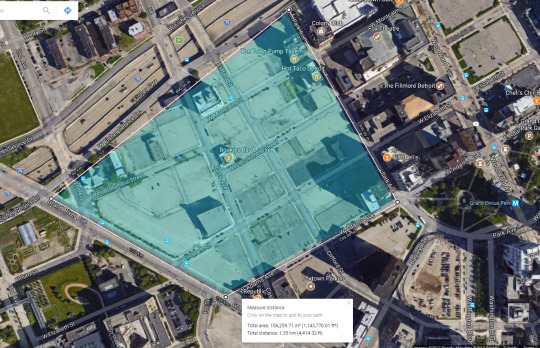
The highlighted area has an approximate dimension of 176,900 square meters of vacancy (plus/minus the presence of some buildings).
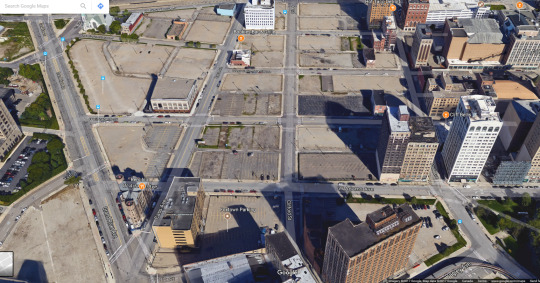
A close up of the area shows how depressing the area appears. Temporarily parking lots are placed where once buildings stood as there is no certainty of the urban plan for this area.

Uptown faces the same issues of large presence of parking areas that make up for a large potion of the space. The gargantuan suburb conveys tens of thousands of drivers every day requiring areas to leave their vehicles somewhere. Although commercial and public volumes required park spots for obvious reasons, they still represent a small percentage compare do the rest.

The red area represents the high-density portion of Detroit while the yellow one is low-density with suburban-type zones. This has been impacting the city for decades: everything revolves around vehicle ownership and those who don’t cannot rely on the weak public transport system or downtown residency.
Crime and high rents have pushed people away from the high-density areas towards the suburbs. Downtown is a corporate fortress that is ‘protected’ by a ring of freeways which doesn’t allow for a smooth transition towards the fringes.
The sprawl of Detroit -like many American metropolis- has impacted the life style of many citizens who are subjugated to the condition their neighbors dwell. In the last 20 years the city has suffered from crime sprees, major city corruption, financial collapse.
To build and to maintain such enormous suburbs required billions of dollars that cannot be made back in tax revenues: low-density neighbors don’t yield enough property taxes. The city was lost with a 20 billion dollar budget gap in 2013 after declaring bankruptcy.
The only way for Detroit to swamp itself out is to drastically rethink its urban design by reshaping vacant lots and abandoned neighbors. Building hi-density zone with enough green and public surface will create a major investment for the future.
At the same time public transportation must be made bigger than it is today, so streetcars and buses will have to increase in fleet size and stop network to provide access to everybody from the city fringes to downtown.
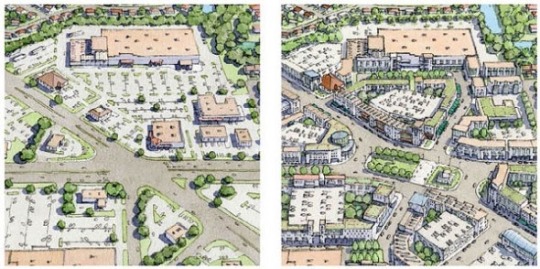
Illustration by Galina Tachieva repairing the sprawl.
Retrofitting neighbors has the best ability to render any city a place worth caring for. Once dead malls and flat surfaces are reborn building gracious communities and promoting pedestrian activity, then everything can become precious again . Areas that are well lit and offer rich patterns in their design will always engage the eye placing more importance in its care and existence.
Detroit can surely use what New Urbanism has done to other cities by reclaiming unused volumes and structures to increase their values by tailoring places around people first and cars second. Redeveloping city blocks opens for new opportunities of business and residential units for mixed using, departing from the old concept of leaving the housing pod with the car just to make small purchases.
